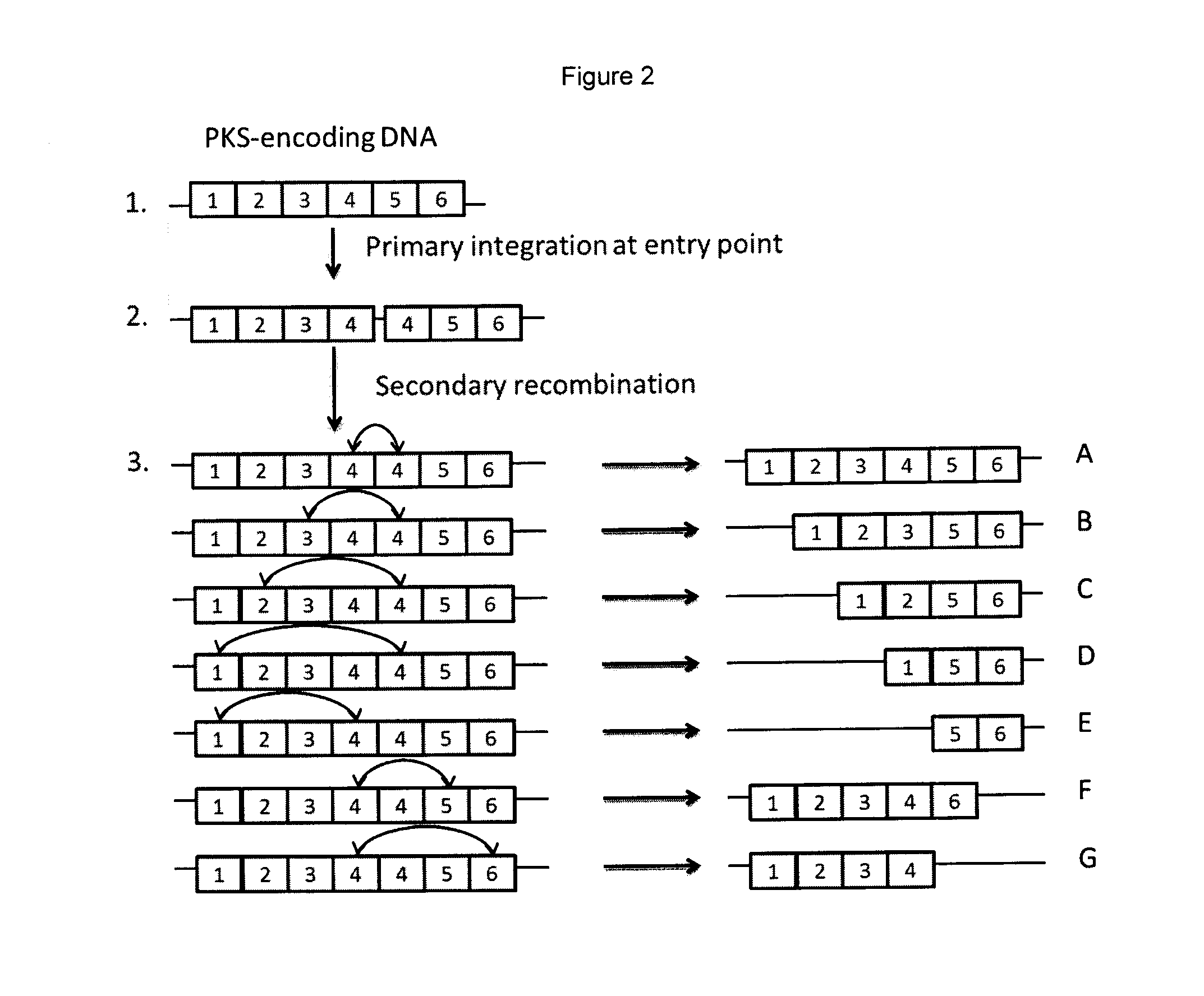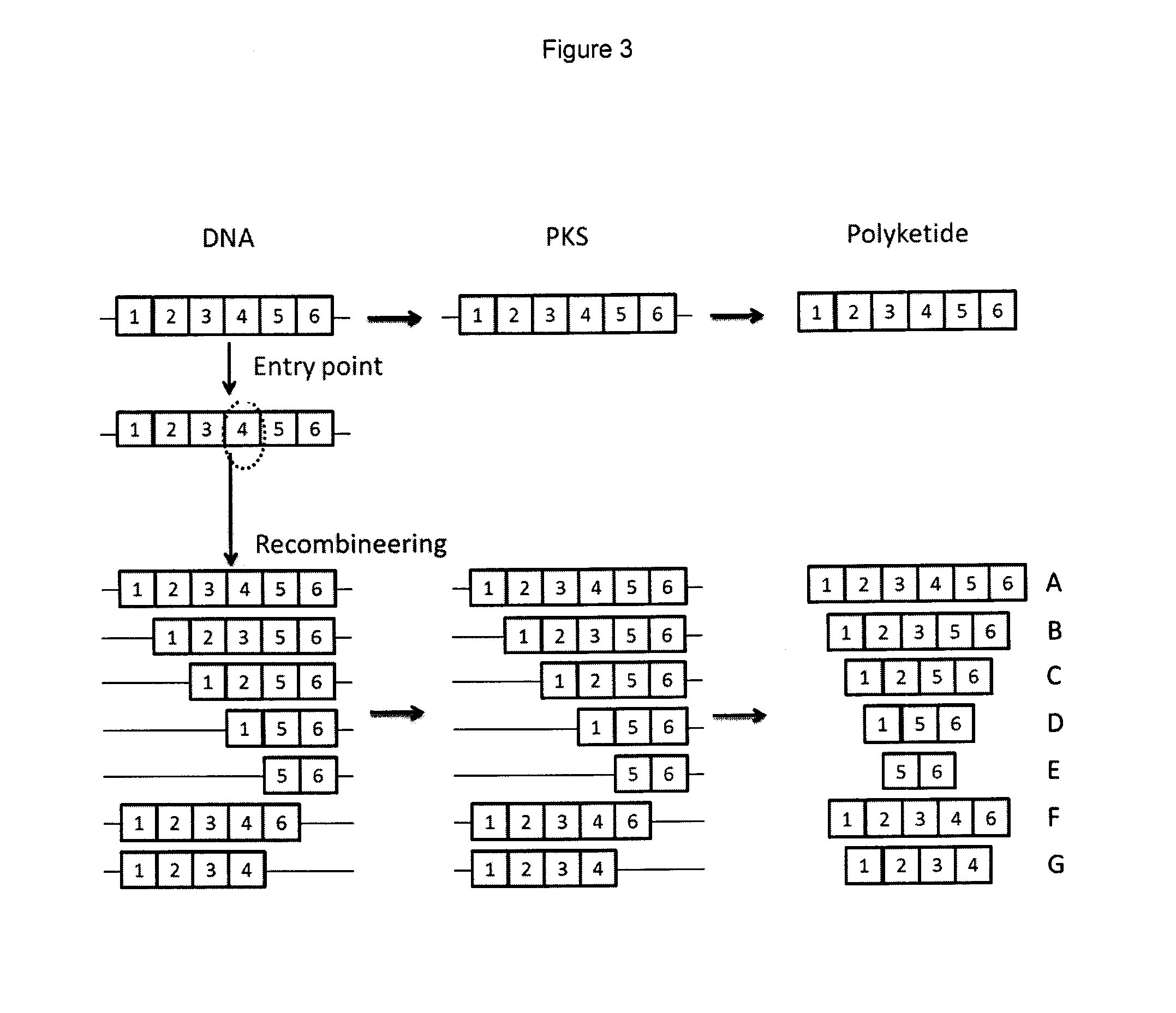Rapamycin analogues and their pharmaceutical use
a technology of rapamycin and analogues, applied in the direction of biocide, drug composition, transferase, etc., can solve the problem of obvious undesirable side effects, and achieve the effect of reducing the inhibition of mtor with maintenance and increasing the inhibition of bacterial mips
- Summary
- Abstract
- Description
- Claims
- Application Information
AI Technical Summary
Benefits of technology
Problems solved by technology
Method used
Image
Examples
example 1
Generation of Constructs Able to Induce Deletion or Expansion of the Rapamycin PKS Modules and Transfer to S. rapamycinicus
[0409]To construct a downstream region of homology two PCR products were ligated together. The first of these two PCR products was obtained using two oligonucleotides (CGACGAATTCCATCGCGCCCCGGCCCGCCAGG (SEQ ID NO: 1) and TTGTCCGGCCGGGTGTCGTACGTCTTCGG (SEQ ID NO: 2)
[0410]to amplify a ˜1.5 kb region of the rapamycin gene cluster using Cos25 (Schwecke et al., 1995) as the template. The second of the two products was obtained using oligonucleotides (CCAGGGACGAGGAGCACGCCGTGTCCATCG (SEQ ID NO: 3) and GGGGTGTAGAGGCTAGCCGCCCTGGCACCGGCCGAGC (SEQ ID NO: 4))
to amplify a ˜0.8 kb region of the rapamycin gene cluster again using Cos25 as the template. Each of these PCR products was treated with T4 polynucleotide kinase and cloned into pUC19 before sequencing to verify the amplified fragment. The first fragment was excised using EcoRI and ApaI and the second fragment excised u...
example 2
Generation of an Alternative Construct Able to Induce Deletion of the Rapamycin PKS Modules and Transfer to S. rapamycinicus
[0417]A series of alternative constructs were prepared to assess the effect of smaller regions (˜1 kb) of homology for recombination.
[0418]Two oligonucleotides
CGCGAATTCGGAGAAACCGGCACCGTCCGCACTGTCCGC (SEQ ID NO: 9) and GGGGTGTAGAGGCTAGCCGCCCTGGCACCGGCCGAGC (SEQ ID NO: 4)
[0419]were used to amplify a ˜1 kb region of homology using intermediate plasmid 1 as a template. The resulting PCR product was kinased using T4 polynucleotide kinase and cloned into pUC19 before sequencing to verify the amplified fragment. The fragment was then excised using EcoR1 and XbaI.
CGTAAAGCTTGGAGACGACACCGTCACCGGCACCGCTGTG (SEQ ID NO: 10) and GTATCTAGAAAGATCTAGTACCCGGGTTGTGGCGGTGCCGAGG (SEQ ID NO: 5)
were used to amplify a ˜1 kb region of homology using intermediate plasmid 2 as a template. The resulting PCR product was kinased using T4 polynucleotide kinase and cloned into pUC19 before s...
example 3
Testing the Genetically Engineered Strains for Production of Novel Contracted Compounds
[0424]Typically 10-15 colonies displaying apramycin sensitivity and derived from each of the primaries were taken forward. Patches were typically grown for around 10-14 days to allow significant mycelial growth and sporulation. An agar plug (about 5 mM in diameter) from each patch was used to inoculate a seed falcon tube containing 7 ml RapV7 media (in a falcon tube) and incubated at 28° C., 300 rpm (1 inch throw) for 48 hours. 0.5 mL of this seed culture was used to inoculate 7 mL MD6 media and incubated at 26° C. and 300 rpm for 6 days; 24 hours into this time each culture was supplemented with 5011 of 0.32M cyclohexane carboxylic acid (CHCA) in methanol (final concentration in media 2 mM).
[0425]For harvest and product analysis 0.9 ml of culture was aliquoted into a 2 mL eppendorf tube and 0.9 mL methanol was added and mixed for ˜30 minutes. Cell debris was pelleted by centrifugation and the liq...
PUM
| Property | Measurement | Unit |
|---|---|---|
| diameter | aaaaa | aaaaa |
| flow rate | aaaaa | aaaaa |
| optical density | aaaaa | aaaaa |
Abstract
Description
Claims
Application Information
 Login to View More
Login to View More - R&D Engineer
- R&D Manager
- IP Professional
- Industry Leading Data Capabilities
- Powerful AI technology
- Patent DNA Extraction
Browse by: Latest US Patents, China's latest patents, Technical Efficacy Thesaurus, Application Domain, Technology Topic, Popular Technical Reports.
© 2024 PatSnap. All rights reserved.Legal|Privacy policy|Modern Slavery Act Transparency Statement|Sitemap|About US| Contact US: help@patsnap.com










